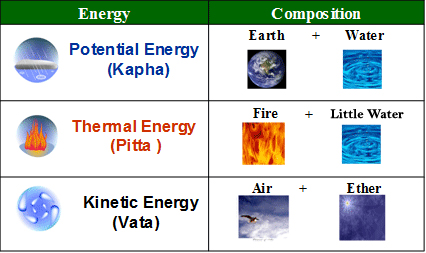Prakriti Analysis - Ayurveda Test To Identify Body Type
Prakriti is your body constitution /Body type. It is some total of one's tridosha percentage (vata, pitta, kapha) in a body. It is the key determinant of how one individual is different from other.
Prakriti has been mentioned in details in Charak Samhita vimaan sthan chaper 8. It is one of the most important investigation of ten investigations regarding patients (Dash vidh pareeksha). It is very important diagnostic tool in Ayurveda.
Establishment Of Prakriti
According to Ayurvedic texts prakriti is established at conception, at the time of fusion of sperm and ovum. Prakriti remains same throughout the life of an individual.
Factors Affecting The Formation Of Prakriti
- Prakriti of sperm
- Prakriti of ovum
- Prakriti of uterine cavity
- Diet of pregnant mother
- Time/season of conception
- Role of Panchmahabhuta
The "Tridosha" Principle For Determining Prakriti
The fundamental theory of Ayurveda is the "Tridosh" principle or the tri-energies theory. This can also be understood as combination of panchbhutas (Five Elements) into three doshas. These are biological or physiological and physical forces that cater to the metabolic functions and structural composition of our body. Kapha is responsible for anabolism. Pitta is responsible for metabolism. vata is responsible for catabolism. The balance of these tri-energies is known as a state of health and their imbalance is disease. Anything which restores this balance is good for health. So specific diet, exercise, behavior or medicine can be recommended according to prakriti to restore this balance and provide health. The tri-energies are:
| Tridosh | Energy counterpart | Elementary Composition |
|---|---|---|
| Vata | Kinetic energy | Air + Ether |
| Pitta | Thermal energy | Fire+ little quantity of water |
| Kapha | Potential energy | Earth + Water |
Relationship Between Vata, Pitta, Kapha And 5 Elements

There is a reference from Charak Samhita sutra sthan chaper 1:44 (Deerghjiveetiya adhayaya)
ह्रास हेतुः विशेष श च प्रवृति: उभय स्य तु
It states that all the tissues (sapta dhatu) in the body can be developed properly if these are nourished by the nutrients similar in nature to them. e.g. shukra dhatu in body is nourished by regular intake of milk and ghee. Similarly lifestyle also affects dosha in the body like by strenuous exercise vata increases in body and by sitting for long hours kapha increases in body. This is a principle of similarity (samanyam).
Same principle is applicable to opposites like Til oil massage (which has properties opposite to vata) in vataj disorder decreases vata. This is a principle of opposition (Vishesh).
To increase any dosha/dhatu in body we choose similar herbs/dietary regimens, while to decrease any dosha/dhatu in body we choose opposite herbs/dietary regimens.
Importance Of Knowing One's Prakriti
According to Ayurvedic texts prakriti tells us about the susceptibility of an individual to develop particular type of diseases throughout his lifetime. There is a beautiful example that if a vata type person develops vataj disorder then its prognosis is difficult. If kapha type or pitta type person develops similar vataj disease then the prognosis is better and disease is likely to be cured easily.
Prakriti Analysis by means of Tridoshas or Trienergies of body plays a very important role in diagnosis and treatment of the disease. Not only this but this Diagnostic tool also helps you to know about particular dietary regimens, herbs, to avoid or to prefer. Prakriti Analysis helps us to maintain healthy life style as well.
Therefore Prakriti Is Important To Know
- Who I am? (On the basis of my vata, pitta, kapha constitution)
- What should I eat?
- What should I avoid?
- What should I eat in moderation?
- What should I eat occasionally?
- What should I follow in my life style?
Prakriti Analysis Test
| # | Characteristics | Vatta | Pitta | Kapha |
|---|---|---|---|---|
| 1 | Body Frame | |||
| 2 | Type of Hair | |||
| 3 | Color of Hair | |||
| 4 | Skin | |||
| 5 | Complexion | |||
| 6 | Body Weight | |||
| 7 | Nails | |||
| 8 | Size and Color of the Teeth | |||
| 9 | Pace of Performing Work | |||
| 10 | Mental Activity | |||
| 11 | Memory | |||
| 12 | Grasping Power | |||
| 13 | Sleep Pattern | |||
| 14 | Intolerance to Weather Conditions | |||
| 15 | Reactions Under Adverse Situations | |||
| 16 | Mood | |||
| 17 | Eating Habit | |||
| 18 | Hunger | |||
| 19 | Body Temperature | |||
| 20 | Joints | |||
| 21 | Nature | |||
| 22 | Body Energy | |||
| 23 | Eyeball | |||
| 24 | Quality of Voice | |||
| 25 | Dreams | |||
| 26 | Social Relations | |||
| 27 | Wealth | |||
| 28 | Bowel Movements | |||
| 29 | Walking Pace | |||
| 30 | Communication Skills |



